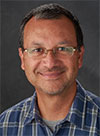
| Dr. Blaise Manga Enuh |
 |
| Researching the invisible world of microbes with computer tools: Insights into improving wastewater treatment and producing bioenergy from agricultural waste |
Tiny invisible architects of life and a journey from hygiene class to scientific discovery Microbes, short for microorganisms, are tiny, invisible living creatures that have had a massive impact on our world. They were discovered in the late 17th century when a Dutch scientist named Antonie van Leeuwenhoek peered through his homemade microscope and marveled at the teeming world of microbes he saw in a drop of water. Today we know these minuscule beings are everywhere, from the soil beneath our feet to the air we breathe, and they come in various forms like bacteria, viruses, and fungi. Although they are often associated with disease, microbes also play essential roles in our daily lives. They help us digest our food, break down waste, and even produce essential products like bread and cheese. In recent years, scientists have also explored how microbes can be harnessed to address environmental issues and develop new medicines, shining a light on their incredible versatility and importance in the natural world. |
| READ MORE |
Dr. Enuh's fellowship is under the supervision of Prof. Daniel Noguera at the Great Lakes Bioenergy Research Center / Wisconsin Energy Institute. |
 |